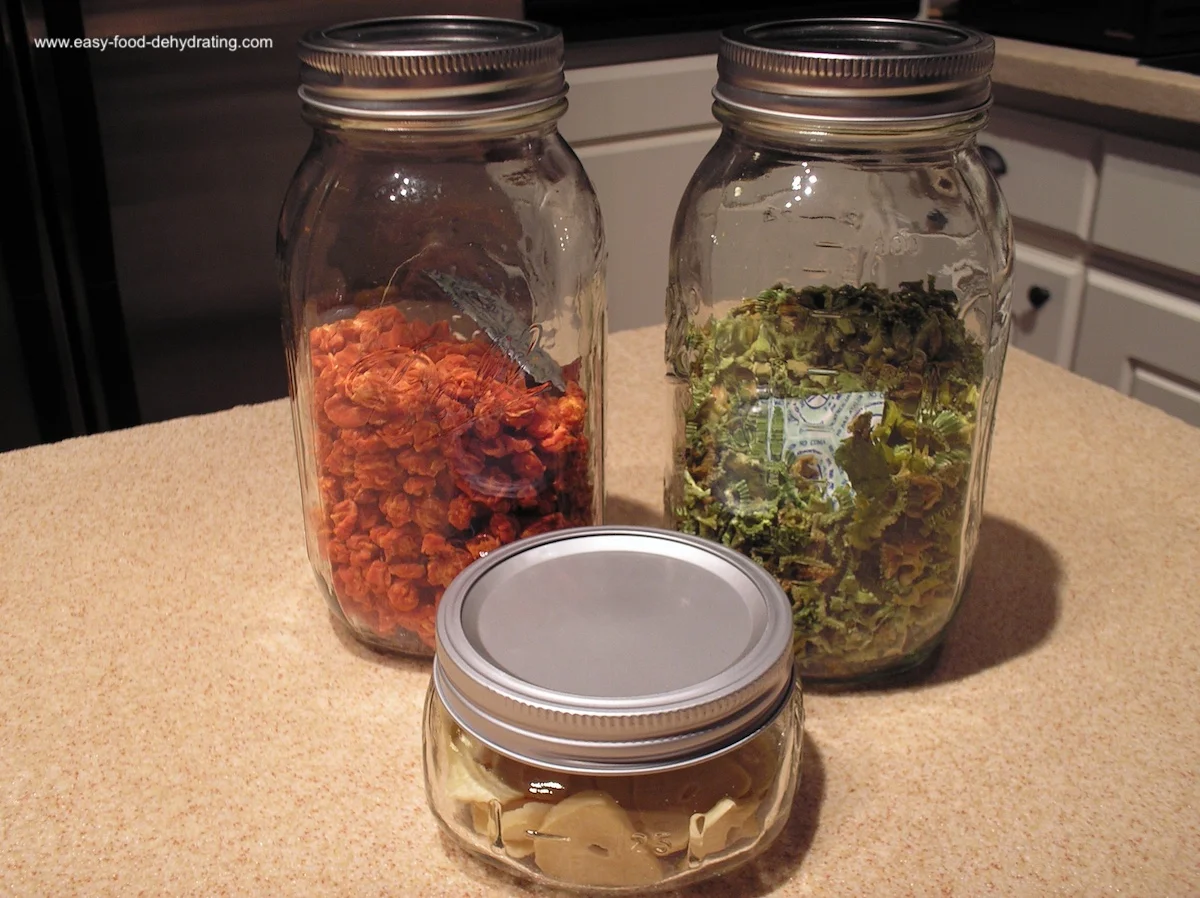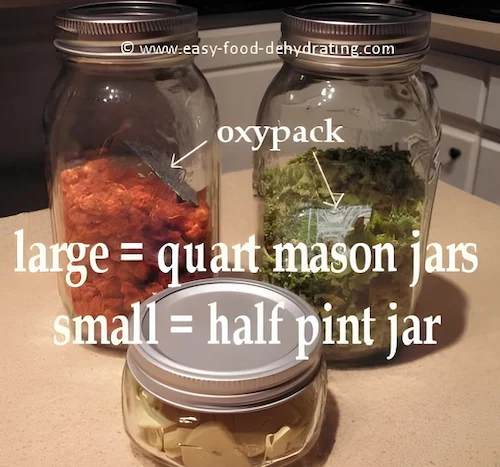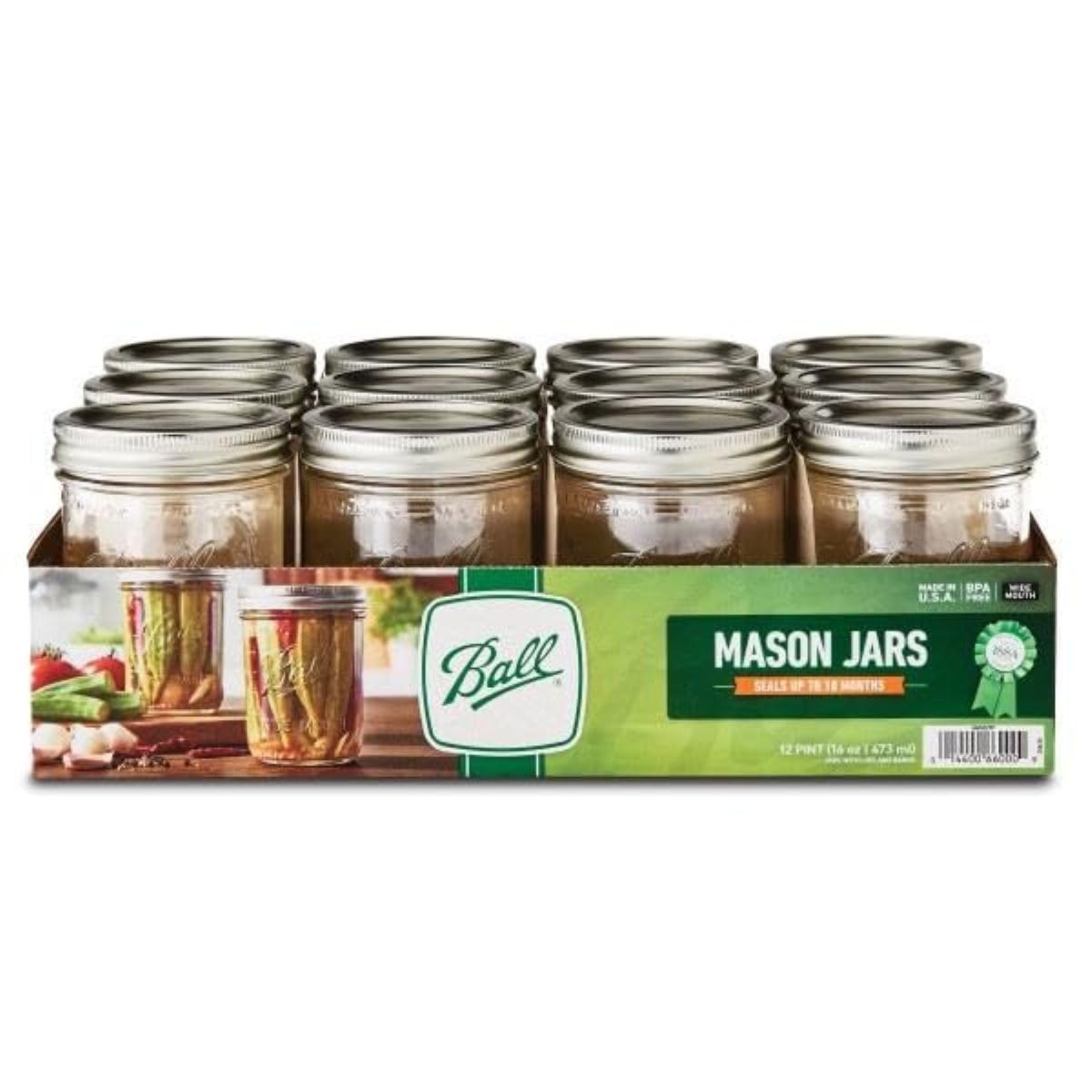What We Mean by “Dehydrate”
Here at Easy Food Dehydrating, “dehydrate” always means using an electric food dehydrator — the easy, reliable way to dry food at home.
- Home
- How to Store Dehydrated Food for Long-Term Freshness
- Mason Jars for Storing Dehydrated Food
Mason Jars for Storing Dehydrated Food:
Smart and Easy Storage

Mason jars are one of the easiest and most reliable ways to keep dehydrated foods fresh, organized, and ready to use. I reach for them daily because they’re airtight, reusable, and let me see exactly what I have on hand.
✅ Quick Answer: Can you store dehydrated food in Mason jars?
Yes! Mason jars are an airtight, reusable, and affordable option for storing dehydrated foods. When sterilized, vacuum-sealed, and paired with oxygen absorbers, they can keep foods fresh anywhere from 6 months to 2 years, depending on the food type and storage conditions.
Whether it’s dried carrots for quick soups or banana chips for snacking, Mason jars make pantry life easier while also protecting food from light, heat, and moisture.

It's a great way to store dehydrated fruit and vegetables for a couple of reasons:
- They are airtight!
- Store easily on your pantry
shelves in the kitchen behind closed doors.
💡 Storage Tip: Even though clear glass looks beautiful, always store jars in a dark cupboard or pantry to protect your dehydrated foods from light damage.
Inside My Pantry: How I Really Use Mason Jars for Dehydrated Foods
 Two rows of my Mason jars inside a kitchen cupboard - filled with dehydrated food!
Two rows of my Mason jars inside a kitchen cupboard - filled with dehydrated food!I keep a stash of dehydrated goodies in Mason jars in a kitchen cupboard! :-) Plus, they look great on our shelves. Impress your friends and family! Go read our "how to dehydrate vegetables" and "how to dehydrate fruit" pages!
TIP: Use smaller air-tight jars (half-pint) for items that you don't use a lot of—such as garlic, and spices.
Ideal Storage for Every-Day Use
I use air-tight Mason jars for storing dehydrated food for everyday use.
When I'm ready to
make a quick soup or need to add some dehydrated vegetables to a
recipe, I can quickly add some dehydrated vegetables without having to
mess around preparing fresh vegetables.
Now don't get me wrong, I'll take fresh vegetables over dehydrated any day, but we're all about doing this for long-term storage and to speed up prep time during the week.
Which Mason Jar Size Works Best for Dehydrated Foods?

Keeping dehydrated vegetables in different-sized Mason jars means I'm not opening up my Mylar bags all the time to retrieve a vacuumed packet and having to re-seal the Mylar bag afterward.
This way, I can quickly grab a jar, pour out what I need, and make a quick vegetable soup.
Shown in the photo are dried carrots, celery, and sliced garlic in the front.
The Clear Advantage: Why Glass Mason Jars Beat Plastic
I like the fact they're made of glass; not only can you see the contents in the jar, but you can see at a glance how much of the contents remain!
But when you ARE ready to refill your jars from your stock, just go pick out one from your stash of stored Mylar bags. Cut off the Mylar bag's top seal, take out a packet (or two), reseal the Mylar bag, and refill your jar!
Important: Do not forget to sterilize your jars before use.
Must-Do Step: 3 Easy Ways to Sterilize Mason Jars for Safe Storage
If you're planning on canning or preserving food at home, it's important to sterilize your Mason jars before use. This will help to prevent the growth of bacteria and mold and will keep your food fresh for longer.
There are a few methods to sterilize Mason jars.
Method 1: Wash the jars in hot, soapy water, and then rinse them well. Next, place the jars upside down on a clean towel and let them air dry.
Once the jars are dry, you can sterilize them by placing them in a preheated oven (200°F) for 10 minutes.
Method 2: Sterilize the jars in a dishwasher. Use the dishwasher as an effective method to sterilize Mason jars as part of the dehydration preparation process - but don't mix the jars along with other dirty dishes!
Running washed/clean Mason jars and lids through a full dishwasher cycle on the hottest wash and dry setting helps achieve sterilization as long as jars come out piping hot from the dishwasher and are used immediately. Don't have them hanging around the kitchen!
Method 3: Boil the jars in a large pot of water for 10 minutes.
Once you've sterilized your Mason jars, they're ready to use. Be sure to fill them with food while they're still hot to help prevent bacteria from growing.
| Method | Pros | Cons |
|---|---|---|
| Oven | Simple and hands-off; no water needed | Takes longer than other methods |
| Dishwasher | Convenient if jars are already clean; minimal effort | Must use jars immediately while still hot |
| Boiling | Traditional and thorough sterilization | Uses more water and energy; requires more handling |
Best Mason Jars for Dehydrated Food (Top Picks)
Mason Jars Regular Mouth Quart Jars
- Ball brand regular mouth Glass Mason Jars. Quart size (32oz)
- Package of 12
Mason Jars Wide Mouth Pint Jars
- Ball brand wide mouth Glass Mason Jars. Pint size (16oz)
- Package of 12
Mason Jars Wide Mouth Half Pint Jars
- Ball brand wide mouth Glass Mason Jars. Half-Pint (8oz)
- Package of 12
Kerr Wide Mouth Half-Pint Mason Jars
- Kerr brand wide mouth Mason jars with lids and bands
- Half pint (8oz)
- Package of 12
As an Amazon Associate, I earn from qualifying purchases — this does not affect the price you pay. Read full disclosure.
👉 Pro Tip: Mason jars sell out fast during canning season—stock up now while you can still find them at great prices!
Fun History: The Surprising Story Behind Mason Jars
The Mason jar was named after its inventor, John Landis Mason. He patented the jar in 1858, and it quickly became a popular choice for canning and preserving food.
As you know, Mason jars are made of glass, and they have a screw-on lid that creates an airtight seal. This makes them ideal for storing food for long-term storage.
Smart Hack: How to Reuse Oxygen Absorbers in Mason Jars
Add a 100cc oxygen absorber in the jar before vacuuming.
Later on, an easy way to tell if the oxygen absorber is 'worn out' is when you take the lid off. If the lid opens without a popping sound, that means you need to replace the old absorber with a new one.
NOTE: I'll keep the 'old/used' 100cc oxygen absorber and put that in the smaller jars (the jars I use for the elephant garlic and spices).
Even though it may not have much 'life' left in the old oxygen absorber, there's usually enough life left in it for a small jar. Change out the old absorber for a new one when you cannot feel any air pop resistance at all when you remove the lid!
A NOTE HERE about DESICCANT PACKETS
Use them in conjunction with Oxygen Absorbers.
Here's How and Why...
Thanks for stopping by to read why Mason jars for storing dehydrated food are ideal for everyday use. Take a moment to check out my review on a great Mason jar sealer by Pawcute here.
Filled Mason Jars are Ideal for Gift-Giving!
Mason jars aren’t just practical for pantry storage—they make wonderful, heartfelt gifts too! You can fill them with dehydrated fruits, soup mixes, or spiced jerky, then add a ribbon and tag for instant charm. For more creative inspiration, be sure to visit my Mason Jar Gifts page and get even more ideas you’ll love.
Your Top Mason Jar Storage Questions, Answered
How long does dehydrated food last in Mason jars?
How long does dehydrated food last in Mason jars?
When vacuum-sealed with an oxygen absorber, dehydrated foods can last 6 months to 2 years. Dark, cool storage extends shelf life even longer.
Do Mason jars need oxygen absorbers for dehydrated food?
Do Mason jars need oxygen absorbers for dehydrated food?
Yes, adding a 100cc oxygen absorber helps keep jars airtight and prevents spoilage. For smaller jars, you can reuse absorbers with partial life left.
What’s the best size Mason jar for dehydrated food?
What’s the best size Mason jar for dehydrated food?
It depends on use! Quart jars are great for soups and large batches, while pint or half-pint jars are perfect for herbs, garlic, and small snacks.
Can you vacuum seal dehydrated food in Mason jars?
Can you vacuum seal dehydrated food in Mason jars?
Yes—using a Mason jar sealer attachment removes oxygen, extending shelf life, preserving nutrients, and saving pantry space.
Do I need to sterilize jars for dehydrated food (not canning)?
Do I need to sterilize jars for dehydrated food (not canning)?
Yes, even for dehydrated food, sterilizing jars before use keeps bacteria and mold at bay, ensuring your food stays safe and fresh.
Keeping dehydrated food in Mason jars makes meal prep fast, safe, and budget-friendly. From hearty soups to crunchy snacks, you’ll love how easy it is to grab exactly what you need.
And while you’re here, don’t miss your free 5 Dried Food Recipes You’ll Actually Love PDF—it includes carrot soup, minestrone, split pea soup, spicy beef jerky, and even banana cinnamon rolls. A tasty bonus for your dehydrated pantry!
Get 5 Dried Food Recipes You'll Actually Love
Here's where you can get your copy of our all new
5 Dried Food Recipes (That Actually Taste Great)
They're my all-time favorite easy dried food meals!
Get it here right now.
For Free!
Before You Go...
If you enjoyed this page, tap the ❤️ in the lower right-hand corner.
It saves this page to your Grow bookmarks so you can find it again later.
You’ll also see quick share buttons to copy the link, post to Facebook,
or save it straight to Pinterest.




















